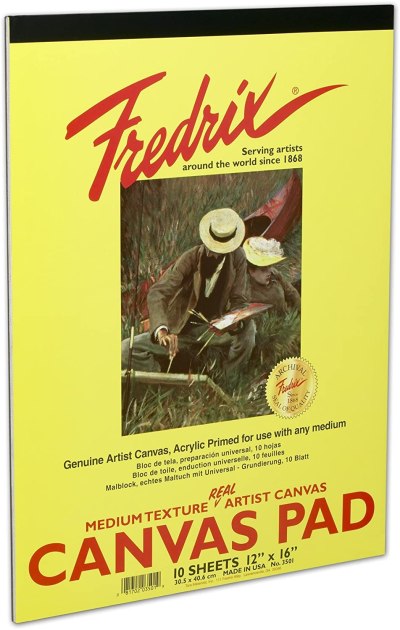[ad_1]
Conventional canvases are generally made from natural fibers woven together, such as linen or cotton, and then stretched over a frame or glued to the panel. A good, portable alternative are canvas pads, which contain either cotton canvas that’s been primed and cut into sheets or primed paper with a texture resembling fabric. Rougher sheets are best suited for artists who prefer wide, bold brushstrokes, while smoother sheets best support fine detailing; depending on how their surfaces are prepared, they can handle mediums as diverse as pastels, oil paints, acrylics, and watercolor. But no matter how great your paint, charcoal, or pens may be, if your canvas pad is not of first quality, the finished artwork will never reach its full potential. A worthy canvas pad absorbs without bleeding, spreads without excess smudging, and boasts a fine texture. ARTnews has compiled below a selection of canvas pads to help you find the most appropriate option.
1. U.S. Art Supply 12″ x 16″ Canvas Paper Pad (Pack of 2 Pads)
The U.S. Art Supply Canvas Paper Pad is a standard, reliable canvas pad of 12 by 16 inches; the pad contains 10 sheets. It’s ideal for acrylic and oil paints, and the paper is 8-ounce and triple primed with acid-free acrylic gesso. This pack of two pads is great for beginners looking to learn the basics of strokes and color mixing on real canvas without the expense of traditional stretched canvas. Those accustomed to a stretched canvas may be disappointed with the lighter material of the paper, which ripples under the weight of prodigious layers of paint. The top-bound paper is easily torn off for framing, and the pad itself is very storable.

2. Canson XL Series Oil and Acrylic Paper Pad
Though the considerable weight of this paper may not be ideal for every medium, it’s great for paint. Sturdy enough for layer upon layer of acrylic or oil paints, it also takes on washes with only minimal curling (to mitigate rippling when using acrylic, try adding thinners instead of water). The pad features 24 sheets of 11-by-14-inch acid-free paper bound in a fold-over cover for easy transport. Practice your skills in the car, on holiday, or from the comfort of home.

3. Arteza Mixed Media Paper Foldable Canvas Pad
With this canvas pad from Arteza, you can paint, draw, or doodle in the center of a sheet and then fold the edges up to create a frame, or down to create a stretcher (there are marked guidelines on each sheet). This is great for those who want to display or gift their artworks without the added expense of having them framed. Like all of their products, Arteza’s canvas pad is of extremely high quality; the heavyweight paper within is capable of supporting many layers of paint (or adhesive, for those interested in mixed-media crafts) without buckling or warping. The sheets are also acid-free, which will help preserve the brilliance of your artwork’s pigments. This 11-by-14-inch pad produces 7-by-8.6-inch framed pieces.

4. Strathmore 300 Series Canvas Pad
Just about anything Strathmore is likely a familiar sight for fine-arts students. The brand’s student-grade 300 series canvas pad contains canvas paper that’s perfect for graphite drawings and oils or acrylic paintings and is capable of withstanding multiple layers of paint without warping, wrinkling, or bleeding through. Just keep in mind that it’s not a perfect substitute for linen or cotton canvas, as paint does absorb differently. Also, there are only 10 sheets per pad, so use sparingly.

5. Fredrix 3501 Canvas Pads
Fredrix is among the most trusted canvas-pad brands for good reason. The papers are thick, acid-free, and primed with titanium white acrylic primer. With a backing of double-layered cardboard, this pad can be taken anywhere and worked on without bending. Some artists may not enjoy working on the paper’s noticeably rough texture, which seems far more coarse than the labeled “medium” and is not ideal for fine detail. But for painters who work fast and loose, especially those who work en plein air, this pad might be perfect.

[ad_2]
Source link

